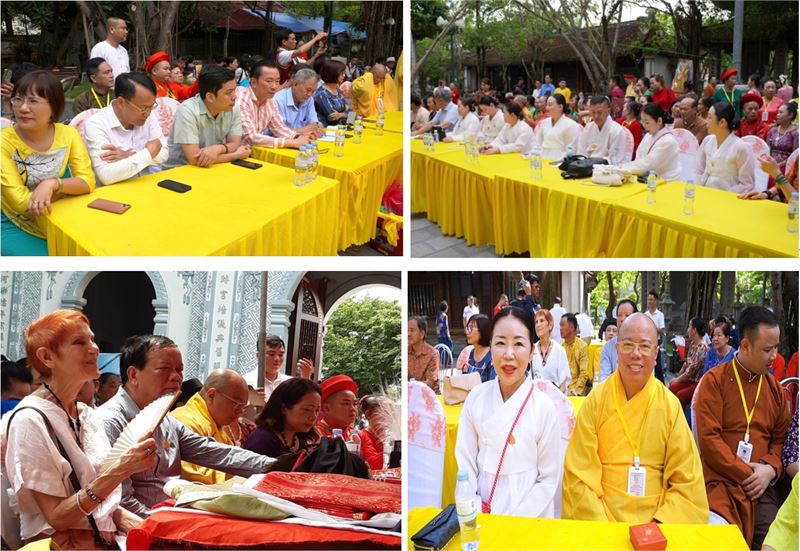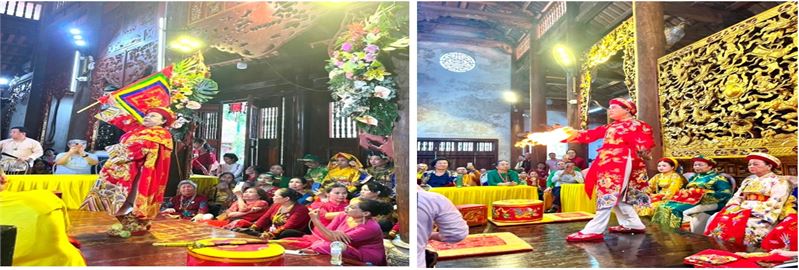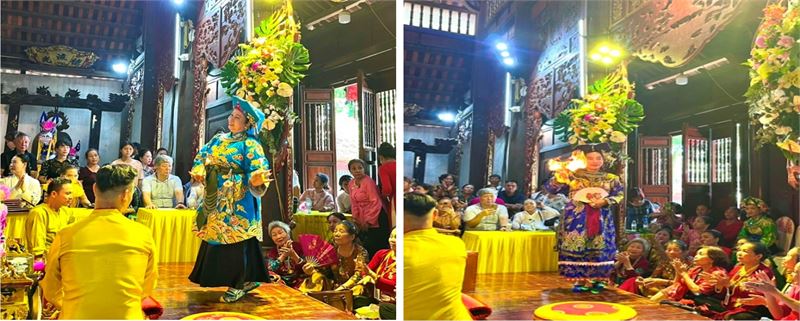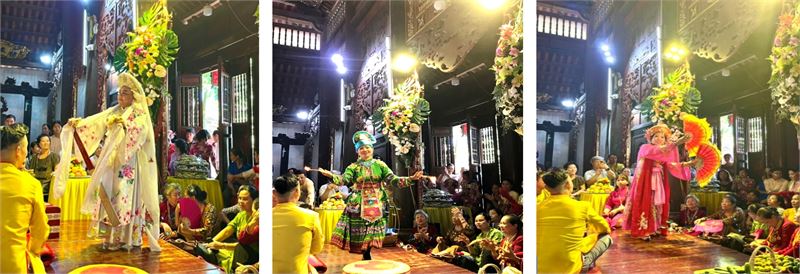Picture 1: The Korean and Vietnamese spirit mediums taking photos together with respected guests and the organizing board.
Best Practices Between ICH Communities Based on Long-Term Commitment and Community-Led Approaches Toward Sustainable Development
On August 2 and 3, 2024, a grand and culturally significant exchange performance took place, highlighting the fruitful cooperation between communities practicing the Viet belief in the Mother Goddesses of Three Realms—an Intangible Cultural Heritage of Humanity recognized by UNESCO in 2016—and Seoul Saenamgut of Korea. This event, held at Lưu Phái Temple in Ngũ Hiệp Commune, Thanh Trì District, Hà Nội, and Tranh Temple in Đồng Tâm Commune, Ninh Giang District, Hải Dương Province, Vietnam, stands as a testament to the long-term commitment and community-led approaches that form the foundation of successful cultural collaborations.
Organized by the Center for Research and Preservation of Vietnamese Religious Culture (the Center) and the Đạo Mẫu Society of Vietnam (Đạo Mẫu Society), in collaboration with the Seoul Saenamgut Preservation Society of the Republic of Korea, this initiative underscores the importance of sustainable development through the preservation and promotion of Intangible Cultural Heritage (ICH). The events were attended by a large number of respected representatives from various cultural and religious management agencies, related research institutions, and non-governmental organizations. These included the Vietnam National Institute of Culture and Arts (Ministry of Culture, Sports and Tourism), the National Council for Cultural Heritage, the Government Committee for Religious Affairs, the Hà Nội Committee for Religious Affairs, the Vietnam Cultural Heritage Association, the UNESCO Association of Hà Nội, and the Human Potential Research Center.
The audience, composed of scientists, journalists, and hundreds of folk artists, spirit mediums, and ritual practitioners—many of whom have been honored with State titles such as People's Artist and Excellent Artist—along with their disciples from various provinces, eagerly gathered to engage in this significant cultural exchange. They were joined by a delegation of 15 representatives from the Seoul Saenamgut Preservation Society of Seoul, Korea, fostering a meaningful dialogue and exchange of traditions.
This event serves as a model for cooperative initiatives between ICH communities, demonstrating how long-term commitment and community leadership can effectively contribute to the sustainable development and preservation of cultural heritage. By bringing together diverse communities and fostering mutual respect and understanding, such initiatives not only preserve intangible cultural heritage but also strengthen the cultural bonds between nations.

Pictures 2, 3, 4, and 5, starting from the top left in a clockwise direction: Distinguished guests and representatives from various cultural and religious organizations, NGOs, heritage bearers and practitioners, local residents, and visitors from afar gathered at the grand opening ceremony.
At the opening ceremony at Lưu Phái Temple on August 2, Associate Professor Dr. Đỗ Văn Trụ, President of the Vietnam Cultural Heritage Association and a member of the National Council for Cultural Heritage, joyfully congratulated the Center on its efforts and achievements following more than a year of organizational consolidation. He commended and encouraged the Center to continue developing international cooperative relationships with cultural and religious practice communities in Korea and other countries, as well as to widely promote the precious values of Vietnam's intangible cultural heritage. He urged Vietnamese artists and spirit mediums to "always be passionate and deeply love cultural heritage, particularly their own intangible cultural heritage (ICH), the Practices related to the Viet Belief in the Mother Goddesses of Three Realms.” He affirmed their roles not only as ICH practitioners but also as spreaders and transmitters of valuable cultural heritage to future generations. Excellent Artist Nguyễn Tiến Nghĩa, Deputy Director of the Center, Chairman of the Đạo Mẫu Society of Vietnam, and custodian of Lưu Phái Temple, welcomed the delegates with warm greetings and expressed his deep desire to continue strengthening and developing the cooperative relationship between the communities of the Đạo Mẫu Society of Vietnam and the Seoul Saenamgut Preservation Society of Korea.
Associate Prof. Dr. Đỗ Văn Trụ, President of the Viet Nam Cultural Heritage Association (shown in the upper Picture 6), and Ms. Jeon Kyung Hae, Secretary-General of the Seoul Saenamgut Society (shown in the lower Picture 7), delivered speeches, stimulating ICH holders and practitioners to safeguard their cultural heritage and encouraging international collaboration.
At the opening ceremony at Tranh Temple on August 3, Dr. Lê Thị Minh Lý, Vice President of the Vietnam Association of Cultural Heritage and a member of the National Council for Cultural Heritage, emphasized the role and active participation of the leaders of the Đạo Mẫu Society and the communities practicing the Viet beliefs in the Mother Goddesses of Three Realms. She highly appreciated and thanked Dr. Park Weonmo, Head of Research and Information Department, International Information and Networking Centre for Intangible Cultural Heritage in the Asia-Pacific Region under the auspices of UNESCO (ICHCAP), and Ms. Jeon Kyung Hae, General Secretary of the Seoul Saenamgut Society, along with its members, for their significant contributions to the preservation of Seoul Saenamgut, an important national intangible cultural heritage of Korea, and for fostering over a decade of exchange and cooperation between the Seoul Saenamgut communities and the communities of the Đạo Mẫu Society of Vietnam.
The exchange, initiated in 2008-2009 through the contributions and strong support of Dr. Park Seong-Yong, former Director of ICHCAP(Intangible Cultural Heritage Centre for Asia and the Pacific), the late Prof. Dr. Ngô Đức Thịnh, former Director of the Research Institute for Folk Culture, and Dr. Lê Thị Minh Lý, former Vice Director of the Cultural Heritage Department (Ministry of Culture, Sports and Tourism), represents a significant collaboration that has continued to foster meaningful cultural ties.
The nearly 40 Vietnamese folk artists and spirit mediums participating in the two-day event had the honor of engaging in practices of devotional worship and spirit possession (hầu đồng) at Lưu Phái Temple, dedicated to the worship of Mother Goddess Liễu Hạnh (one of the four immortals and the principal deity of the Mother Goddess worship in Vietnam) and the Third Great Mandarin (Quan Lớn Đệ Tam), a historical figure renowned for his significant contributions to the country on the occasion of his birthday celebration. They also performed at Tranh Temple, which is dedicated to the worship of the Fifth Great Mandarin Tuần Tranh (Quan Lớn Đệ Ngũ), a talented national hero with notable contributions to the country. Both temples are grand and splendid national historical and cultural relics recognized by the State. The rituals were performed in the presence of a large audience, including distinguished guests from the Seoul Saenamgut Society of Korea. The chầu văn music and the hầu đồng performances were meticulously executed by the artists, adhering to traditional standards in terms of procedure, attire, gestures, demeanor, appearance, and the spirit of the characters.
Hầu đồng, an important ritual of the Viet belief in the Mother Goddesses of Three Realms (also known as the Mother Goddess religion or Đạo Mẫu in Vietnamese, an indigenous belief of the Vietnamese people that emerged around the 16th century) and Seoul Saenamgut of Korea, both share similarities with strong Taoist influences and shamanic characteristics, such as communicating with deities to ward off evil spirits, seek healing, good fortune, and prosperity, yet they also have unique and distinctive elements.
In hầu đồng, there are a total of 36 incarnations, each lasting at least 15-20 minutes. Each incarnation is a spiritual possession and rebirth of a deity within the Đạo Mẫu pantheon, performed in hierarchical order from highest to lowest rank. The ritual begins with the invocation of the Holy Mothers, including:
Heavenly Mother Goddess (Mẫu Thượng Thiên), an incarnation of Holy Mother Liễu Hạnh, who is always in red and sits at the center of the Mother Goddess rank. She holds creative powers and governs the heavens. Holy Mother Liễu Hạnh became the principal deity of the Vietnamese Mother Goddess religion and one of the Four Immortals in Vietnamese legend.
Mother Goddess of Mountains and Forests (Mẫu Thượng Ngàn), who wears green and governs the forests and mountains.
Mother Goddess of Water (Mẫu Thoải), who wears white and governs rivers and waters.
Earthly Mother Goddess (Địa Tiên Thánh Mẫu), who wears yellow and governs land and all living creatures.
Following the invocation of the Holy Mothers, the ritual proceeds to the ranks of the five Great Mandarins (Quan lớn), four Holy Ladies (Chầu bà) who are direct incarnations of the four Holy Mothers, then comes the ranks of five Princes (ông Hoàng), twelve Princesses (Cô), and twelve young Princes (Cậu). These deities, either heavenly or historical figures who are mostly national heroes with significant contributions to the nation, manifest themselves through the mediums' bodies, each wearing special costumes in one of the four symbolic colors of the four realms (red for the palace of heaven, yellow for the earth, green or blue for mountains and forests, and white for water), showcasing their wisdom, talents, and personalities through various actions, beautiful gestures, and exciting dances, while bestowing blessings and fortune upon the attendees.
Pictures 8 (Left) & 9(right) : Incarnation of Young Prince, starting with invocation of Holy Mother with a red veil, practiced by Excellent Artist Đỗ Thị Vui, Vice Chairperson of Đạo Mẫu Society, Chairperson of Đạo Mẫu Society, Hà Nội

Picture 10 (left): Incarnation of Saint Trần, practiced by Excellent Artist Nguyễn Thi Bình, Chairperson of Woman Sacrificial Team, Lê Chân, Hải Phòng province
Picture 11(right): Incarnation of the First Great Mandarin, practiced by Trần Văn Cường, Chairperson of Đạo Mẫu Society, Nam Định province.
Picture 12 (left): Incarnation of the Fourth Great Mandarin practiced by folk artist Đỗ Thị Nga, Vice Chairperson of Đạo Mẫu Society of Hải Dương province.
Picture 13 (right): Incarnation of the Fifth Great Mandarin, practiced by Folk Artist Vũ Thúy Hoàn, Vice Chairperson of Đạo Mẫu Society of Tuyên Quang province.

Picture 14 (left): Incarnation of the Fifth Lady, practiced by artist Đinh Thị Ca, member of Đạo Mẫu Society of Hà Nội.
Picture 15 (right): Incarnation of the Sixth Lady, practiced by artist Đinh Văn Dũng, member of Đạo Mẫu Society of Hà Nội.

Picture 16 (left): Incarnation of the Third Princess, practiced by spirit medium Phan Thanh Tương, Chairperson of Đạo Mẫu Society of Quảng Nam province.
Picture 17 (middle): Incarnation of the Eighth Princess, practiced by spirit medium Nguyễn Thị Huệ, member of Đạo Mẫu Society of Đà Nẵng city.
Picture 18 (right): Incarnation of the Ninth Princess, practiced by Folk Artist Nguyễn Thị Liễu, Chairperson of Đạo Mẫu Society of Bắc Ninh province.
In contrast, Seoul Saenamgut is a ritual from the Seoul region of Korea, performed to console the souls of the deceased and guide them to a better afterlife. The Saenamgut ceremony comprises two parts: The first is Andang Sagyeongmaji (from midnight until dawn), primarily to pray for peace for the living, and the second is Saenamgut (conducted the next morning and lasting longer), which is to guide the deceased to the other better world.
If performed in full, the ceremony may last over 12 hours, beginning with the invocation of the deities. However, during this cultural exchange, the Korean mediums only performed some basic parts of the ritual that took over two hours. Their demonstration captivated the audience's interest, led to enthusiastic exchanges, and left a profound impression on the participants and local residents.
Picture 19 (left): Seoul Saenamgut ritual
Picture 20 (right): Seoul Saenamgut spirit medium burning the petitions

Picture 21(Left): Musicians of the Seoul Saenamgut
Picture 22 (left) & 23 (right): Preparing for an incarnation
Picture 24 (left): Korean mediums demonstrating key elements of Seoul Saenamgut at Tranh temple, capturing great attention and active response of the Vietnamese and international audience.
Picture 25 (right): Participants and visitors were joyfully attracted by the incarnations lively practiced by the Vietnamese mediums.
Picture 26 (left) & 27 (right): Granting Certificates to the Vietnamese and Korean mediums.
Closing Session:
At the closing session of the cultural exchange program, Ms. Jeon Kyung Hae, Secretary General of the Seoul Saenamgut Society, sincerely thanked the Center and the Đạo Mẫu Society’s communities for their organizational efforts and warm hospitality. She expressed her determination to maintain and further develop this valuable cooperative relationship between the ICH practicing communities of Vietnam and Korea.
Picture 28: Ms. Jeon Kyung Hae, Head of the Seoul Saenamgut Society Group expressed her thankfulness to the Vietnamese partners and her commitments to future cooperation.
Conclusion:
This meaningful cultural exchange program helps to maintain the prayers for peace and well-being of the people in Seoul Saenamgut, as well as the strong belief in the compassion and grace of the Mother Goddesses in Vietnam. It contributes to forming social relationships and connecting members of participating communities. Such exchanges not only link communities within a country but also connect with those in other countries that share similar cultures, thereby fostering community exchanges and contributing to the sustainable development of intangible cultural heritage in the international community.
-------------------------
Contributed by Ms. Nguyễn Kim Dzung, an international reporter at Arirang Culture Connect, a global intangible heritage online newspaper.
The pictures of the event in this article were provided by the Đạo Mẫu Society of Vietnam and Nguyễn Kim Dzung.
Ms. Nguyễn Kim Dzung, currently an international reporter at Arirang Culture Connect, is also the Deputy Director of the Center for Research and Preservation of Vietnamese Religious Cultures (CVRC). She has a long career in cultural heritage, including key contributions to Vietnamese cultural policy and UNESCO nominations while leading the Intangible Cultural Heritage Management Division at the Department of Cultural Heritage from 2003 to 2014. She joined CVRC in 2023 after her retirement.